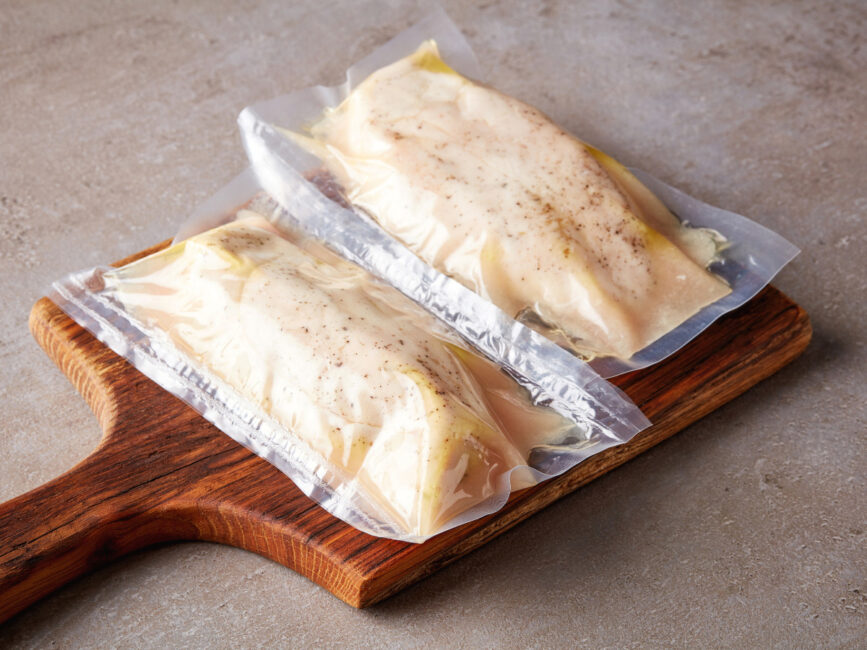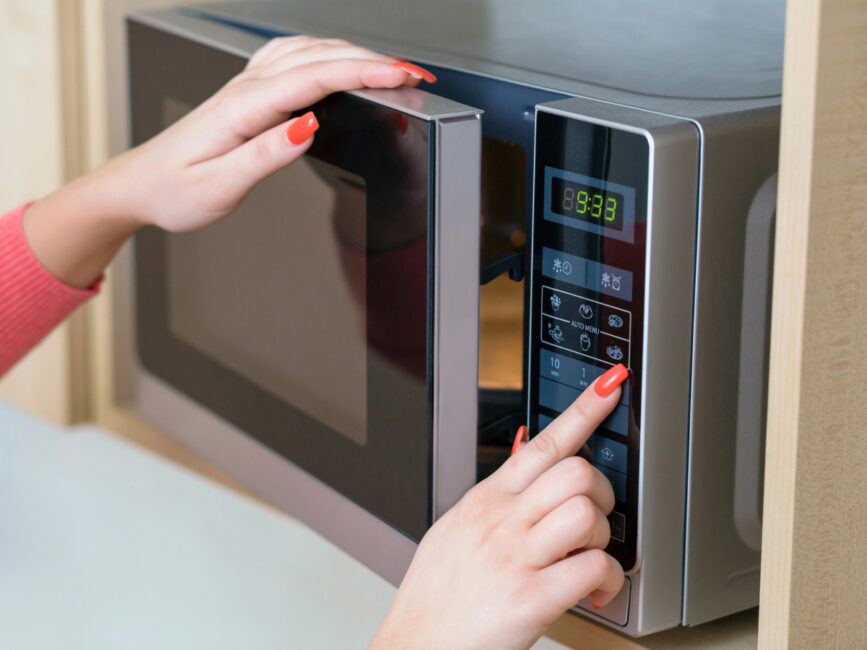Have you ever found yourself staring at a solid block of frozen chicken mere hours before dinner time, and prayed for a magic wand that could make it ready to cook instantly? You’re not alone! We’ve all been there.
You know you need to whip up that meal, but in reality, you mayyyy have forgotten to defrost it. (Whoops!)
So, the big question is: Can you really zap your frozen chicken into a ready-to-cook state using your microwave, or is this just a kitchen myth waiting to wreak havoc on your dinner plans?

Can You Defrost Chicken in the Microwave?
The short answer? Yes, you can defrost chicken in the microwave, and it can be a game-changer for those last-minute meal preps.
Microwaves are equipped with a handy defrost setting that’s designed to bring your frozen chicken to a safe temperature range without cooking it. Whether it’s a single chicken breast for a quick salad or a pound of chicken thighs for a hearty stew, your microwave can save you a ton of time.
But here’s the kicker: You have to make sure you do it the right way to avoid that danger zone of bacterial growth. Let’s dive into how to use this kitchen shortcut safely.

Understanding the Risks
Who was it that first said “With great power comes great responsibility?” Was it Yoda? Uncle Ben? (Of the Spiderman universe, not the rice guy.) Winston Churchill? Whoever it was, using the microwave to defrost chicken is no exception to this rule. Here are some tips on what to look out for when you defrost chicken in the microwave.
- Keep Your Chicken Out of the Danger Zone: The primary concern is bacterial growth, a HUGE issue with improperly thawed chicken. Bacteria love to party in the “danger zone,” the temperature range between 40°F and 140°F, where they multiply rapidly. This is why it’s important to ensure even thawing, and avoid causing parts of the chicken to become hot, while other parts remain frozen. Foodborne illness is no joke, and the U.S. Department of Agriculture (USDA) emphasizes the importance of keeping raw chicken out of the danger zone to prevent the spread of harmful bacteria. The defrost setting on your microwave is specifically designed to reduce this risk by lowering the wattage, allowing the chicken to thaw without the water temperature around it increasing too much.
- Check Your Chicken in the Microwave: This doesn’t mean you can just set it and forget it. (Your microwave is not a slow cooker, unfortunately.) You have to make sure you properly adjust the defrost time according to the weight of the chicken, as well as frequently check to ensure there are no ice crystals left in the meat.
- Cook Your Chicken ASAP: On top of these rules, chicken thawed in the microwave should be moved to the cooking phase immediately to maintain food safety.
- NEVER Leave At Room Temp: Despite what your mom, aunty or meemaw used to swear by, frozen chicken should NEVER be left at room temperature to thaw. This is the absolute surest way to invite bacterial growth, and thus, food poisoning.
Microwaving chicken can save you time, but requires your attention to do it right. By understanding the risks involved, especially the concern over bacteria growth at unsafe temps, you can cook that chicken quicker without compromising the health of you or the people you’re feeding.

How to Defrost Chicken in the Microwave Safely
Defrosting chicken in the microwave isn’t just about pushing a button and hoping for the best. When done correctly, this process will make sure your chicken is safely thawed and ready for cooking. Here’s how to do it right:
Choose the Right Container
- Use Microwave-Safe Containers: The first step is to transfer your chicken from its original packaging into a microwave-safe container. Glass or ceramic dishes are usually the best options as they don’t pose a risk of leaching chemicals into your food, unlike some plastics.
- Avoid Harmful Plastics: Not all plastics are created equal. Steer clear of containers that are not labeled as microwave-safe, as they can release harmful chemicals into your chicken. Look for containers marked as microwave-safe or with the PP symbol (Polypropylene can withstand temperatures of up to 260°F) or use alternatives like glass that are inherently safe for microwave use.
Set the Microwave Correctly
- Use the Defrost Setting: Most microwaves have a defrost function, which usually operates at about 30% full power. This setting is designed to minimize the risk of cooking the edges of the chicken while the middle remains frozen.
- Estimate Defrosting Time: Set the defrost time based on the weight of the chicken. A good starting point for most raw meat is to defrost for 8-10 minutes per pound, but you’ll need to adjust this based on your microwave’s wattage and the size and thickness of the chicken pieces.
Step-by-Step Process
- Position the Chicken: Place the chicken in a microwave-safe dish and spread out the pieces evenly. If you’re defrosting a whole chicken or larger pieces like chicken thighs, place the thicker parts towards the outer edges of the dish.
- Flip and Rotate for Even Thawing: Check your chicken at every 1 minute interval. Halfway through the defrosting time, pause the microwave to flip and rotate the chicken pieces. This helps ensure that the chicken thaws evenly, and reduces the risk of some parts defrosting too quickly or begin to cook.
Post-Defrosting Steps
- How to Tell if Your Chicken has Defrosted Properly: Cut a slit in the thickest part of your chicken. Insert your fingers to check for hard, cold spots or ice crystals. A fully soft chicken is ready for cooking. If you find that the meat of your chicken is still frozen in some areas or if you notice ice crystals, defrost for a bit longer, then check again.
- Cook It Immediately: Chicken defrosted in the microwave should be cooked immediately after thawing. Your chicken may have reached a temperature in the microwave that encourages bacterial growth. Cooking it right away will kill any bacteria present.

Tips for Defrosting Chicken in the Microwave Oven
For the best results, here are a few tips to keep in mind:
- Cut Chicken into Smaller Pieces: If time allows for it, cutting your chicken into smaller pieces can make it much easier to thaw. This is especially useful for larger cuts like chicken breasts or whole chickens.
- Partially Defrost Chicken for Easier Cutting: If you’re planning to cut the chicken into smaller pieces or strips for a recipe, partially defrosting it in the microwave first can make it easier to slice.
Alternatives to Microwave Defrosting
While the microwave offers a quick fix for defrosting chicken, it’s not your only option. Knowing your methods can help you choose which one works best for you, given your time and needs.
Refrigerator Thawing: Safest, but Requires Planning
The refrigerator defrost option is the safest way to defrost chicken, since it keeps the chicken at a safe, constant temperature, and well below the danger zone for bacterial growth. But, it requires preparation. A whole chicken or large cuts might need up to a full day or two to thaw completely. To start, place your chicken in a large, sealed sandwich bag. Place that bag on a plate that will keep any leaking juices from getting onto any of your other food items. Place this dish on the bottom shelf of your fridge until thawed.
Cold Water Bath: Faster than the Fridge, but Requires Supervision
For a quicker method than refrigerator thawing, consider the cold water method. Submerge your chicken in a zip-lock bag to prevent water from soaking in. Place it in a large bowl of cold water. Change the water every 30 minutes to keep it cold. The thawing time for this method is about 1-3 hours, depending on the size of the chicken.

Frequently Asked Questions
Can you refreeze chicken that has been defrosted in the microwave?
Yes, BUT: If the chicken was thawed in the microwave, it should only be refrozen after it has been cooked. Refreezing raw chicken that was thawed in the microwave increases the risk of bacterial growth and foodborne illness. Refreezing chicken that was thawed in the fridge is fine within the first 48 hours of thawing.
How long does it take to defrost chicken in the microwave?
Microwave defrosting time depends on the weight of the chicken and the power level of your microwave. Generally, it takes about 8-10 minutes per pound on the defrost setting. However, it’s important to check the chicken regularly and adjust the time as needed to ensure even thawing.
What do you do if the edges of the chicken start to cook while you’re defrosting?
If you notice the edges of the chicken start to cook while defrosting in the microwave, stop the defrost cycle and let the chicken rest for a few minutes to redistribute the heat. You can then continue defrosting at a lower power level or shorter intervals, flipping and rotating the chicken to prevent overheating.

Now You Know!
Defrosting chicken in the microwave can be a great time-saver, but it’s super important to prioritize safety when doing so. By following this advice properly, you can safely and effectively thaw your chicken so that it’s ready to cook ASAP!
We’d love to hear from you! Have you tried defrosting chicken in the microwave? Do you have any tips or experiences to share? Drop your thoughts in the comments below!







